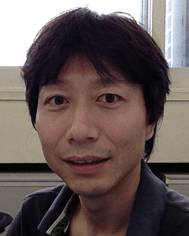 Open Access Article
Open Access ArticleCreative Commons Attribution 3.0 Unported Licence
Recent twists in photoactuation and photoalignment control
Arri
Priimagi
ab,
Christopher J.
Barrett
c and
Atsushi
Shishido
*d
aDepartment of Applied Physics, Aalto University, P.O. Box 13500, FI-00076 Aalto, Finland
bNFMLab-DCMIC “Giulio Natta”, Politecnico di Milano, Via L. Mancinelli 7, IT-20131 Milano, Italy
cDepartment of Chemistry, McGill University, 801 Sherbrooke Street West, Montreal, Quebec H3A 0B8, Canada
dChemical Resources Laboratory, Tokyo Institute of Technology, R1-12, 4259 Nagatsuta, Midori-ku, 226-8503 Yokohama, Japan. E-mail: ashishid@res.titech.ac.jp
First published on 30th June 2014
Abstract
The design of functional and stimuli-responsive materials is among the key goals of modern materials science. The structure and properties of such materials can be controlled via various stimuli, among which light is often times the most attractive choice. Light is ubiquitous and a gentle energy source and its properties can be optimized for a specific target remotely, with high spatial and temporal resolution. Light-control over molecular alignment has in recent years attracted particular interest, for potential applications such as reconfigurable photonic elements and optical-to-mechanical energy conversion. Herein, we bring forward some recent examples and emerging trends in this exciting field of research, focusing on liquid crystals, liquid-crystalline polymers and photochromic organic crystals, which we believe serve to highlight the immense potential of light-responsive materials to a wide variety of current and future high-tech applications in photonics, energy harvesting and conversion.
Introduction
Liquid crystals (LCs), sometimes coined as “the fourth state of matter”, are now ubiquitous in our everyday lives. Lying in between isotropic liquids and crystalline solids, LCs combine the mobility of the former and the orientational order of the latter. Due to molecular cooperative motions, the orientation of LC molecules can be externally controlled, which makes them attractive as “macroscopic molecular switches” and actuators. The cooperative motions constitute the very basis of the immense technological potential of LCs.1–4 By incorporation of cleverly designed photoresponsive molecules into the LCs, molecular alignment can be precisely controlled over large areas. This enables the fabrication of specialty light-responsive materials for photonic applications such as optical switching and signal processing, lasing, and actuation.5–8One of the most sophisticated light-control schemes is based on reversible photoswitching through incorporation of photochromic units into a host material system. Azobenzene derivatives, for example, through a reversible trans–cis geometric isomerization,9 can be used to construct molecular-level switchable systems,10 to control self-assembly and aggregation of supramolecules11 or the structure and function of biomolecules,12,13 and to design stimuli-responsive macroscopic actuators, micromotors, and photodeformable materials. In other examples, simple absorbing dyes can be used to bring about enhanced response of the material system to optical fields.14,15
Photoinduced molecular realignment based on azobenzene dates back to holographic recording experiments by the groups of Todorov16 and Wendorff17 in the 1980s. Ichimura et al. were the first to propose a command surface concept to control the orientation of LC molecules by means of a photoresponsive surface.18,19 Tazuke et al. demonstrated photochemical phase transitions, i.e., that the photoisomerization process can disrupt the LC phase and turn the material isotropic.20 In the early 2000s, crosslinked LC systems emerged as a new class of materials for photoalignment control. Finkelmann et al. showed the photocontraction of LC elastomers,21 and the Ikeda group demonstrated the photoinduced bending of crosslinked LC films.22,23 Those macroscopic LC actuators are based on amplification of the motion generated by molecular-level switches through cooperative effects that take place in liquid crystals. Interestingly, such photoinduced cooperative effects were also reported in photochromic crystals by the Irie group.24 Compared to elastomers, crystals can exhibit faster photomechanical actuation because of their higher Young's modulus, rendering them an intriguing new class of photomechanical materials.
The purpose of this review is to highlight, through selected recent examples, some significant leading examples of photocontrol achieved over molecular alignment in the design of macroscopic photoswitchable materials and light-driven actuators, and some emerging trends evolving at these fronts. The discussion here is limited to inherently ordered materials, that is, to liquid crystals and crystals. We would like to emphasize that several comprehensive reviews on both photoresponsive liquid-crystals and photomechanical materials have appeared over the past few years,6,25–27 which serve to demonstrate that the field is still timely and pertinent despite its relatively long history. We start by outlining some recent advances in azobenzene-based photoalignment control, present some new trends in photoalignment control in non-azobenzene systems, and then move on to photomechanics and actuation in liquid-crystalline and crystalline systems before concluding with some remaining challenges and future perspectives.
New directions in photoalignment control
It has been 30 years since research on light-induced molecular alignment control in photoresponsive azobenzene-containing polymer films started receiving wider attention due to their potential in photonic applications. Todorov et al. observed linearly polarized-light induced birefringence and polarization-holographic gratings in amorphous poly(vinyl alcohol) films doped with Methyl Orange16 and Eich, Wendorff et al. extended these studies to liquid-crystalline polymers that enabled reversible holographic gratings with higher diffraction efficiency to be inscribed.17 Motivated by these pioneering studies, many other photochromic materials were proposed shortly thereafter.28,29 A wide range of applications in, for example, optical storage, holography, optical switching, display technology, and so on were proposed for these material systems, responding to the changing times and needs.30–33 Today, surface photoalignment techniques for controlling the orientation of liquid crystals are of significant industrial interest and are challenging the conventional rubbing-based alignment layers in display technologies.34,35 The photoalignment layers enable remote and reversible control over anisotropic molecular arrangement, which in turn allows one to control optical properties, e.g., light propagation through liquid crystals.36–39 On the other hand, photoalignment control in polymeric LC films is interesting in its own right in view of photonic applications.40 Herein, we highlight recent examples on (1) photoalignment control of LC polymers, (2) new photoalignment materials that undergo photochemical reactions, and (3) recent advances in photophysical alignment control of LCs.Conventionally, the photoalignment control of LC materials has been based on either photoinduction of anisotropy in thin alignment layers, so-called command surfaces,19 or incorporating photoresponsive units into the bulk of the liquid crystal material.34 A new strategy, based on free-surface molecular command systems, was recently proposed by the Seki group.41 They blended a small amount of an azobenzene-containing block copolymer (azo-BCP) into a non-photoresponsive LC polymer. The LC polymer spontaneously adapts a homeotropic alignment on clean quartz slides but upon blending, the azo-BCP segregates to the LC–air interface and acts as a “free-surface command layer” that allows for in-plane photoalignment control of the LC polymer with linearly polarized light. The free-surface command layers can be removed after the photoalignment process, and they can be inkjet-printed onto the material surface to induce homeotropic-to-planar realignment at high spatial resolution as demonstrated in Fig. 1. This strategy is applicable to various types of material systems and requires no modification of the substrate surface.
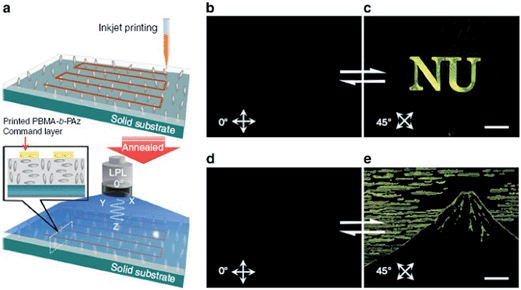 | ||
| Fig. 1 (a) Schematics of the inkjet printing of a free-surface command layer onto a homeotropically aligned, non-photoresponsive LC polymer. After printing, the film was annealed at 125 °C for 10 min and successively irradiated with linearly polarized light at 80 °C. (b–e) The inkjet method allows one to locally control the LC polymer alignment with high spatial resolution, as is evident by observing the inkjet-printed samples between crossed polarizers at different orientations. Reproduced with permission from ref. 41. Copyright 2014, Nature Publishing Group. | ||
Another recent development in photoalignment control that we would like to highlight is the use of azobenzene-containing ferroelectric LC polymers as switchable second-order nonlinear optical materials.42 Such materials are difficult to realize in bulk because second-order NLO materials must meet the requirement of noncentrosymmetric molecular alignment of the molecular constituents. Recently, a method based on azobenzene-triggered macroscopic order–disorder molecular alignment changes in crosslinked ferroelectric LC polymers was proposed that provides high-contrast and reversible switching, as shown in Fig. 2. To circumvent the problem of the large extinction coefficient of azobenzene moieties, two-photon excitation was applied for efficient switching through the bulk of the material.42
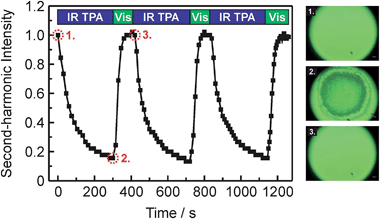 | ||
| Fig. 2 IR-light-induced two-photon isomerization efficiently suppresses the second-harmonic generation of crosslinked ferroelectric LC polymers, with a contrast of up to 20. Visible-light-induced reverse isomerization quickly restores the signal to its initial value. Based on the polarized-optical micrographs shown on the right, the suppression is caused by macroscopic order–disorder molecular alignment change triggered by photoisomerization of azobenzene. Reproduced with permission from ref. 42. Copyright 2012, Wiley-VCH. | ||
New materials have also been developed to accommodate specifications required for various photonic applications. Photochemically reactive materials with advantages of colourlessness and thermal stability, for example, are important from the viewpoint of display technologies.34 Unlike the conventional cinnamate-containing liquid-crystalline polymers,36,43,44 Kawatsuki et al. reported photoinduced reorientation of a photopolymer with 4-methoxy-N-benzylideneaniline side groups for holographic applications.45 Large birefringence of >0.1 is obtained in the colourless system. Stumpe and coworkers have recently demonstrated novel types of colourless photorotors for the induction of anisotropy, with dichroism values up to 0.2.46 Finally, Kosa et al. reported on naphthopyran-containing liquid crystals that can undergo order-increasing photoinduced phase transitions with large photoinduced dichroism, with potential implications in ophthalmic applications.47
Photophysical systems, i.e., materials in which the photoalignment control is provided by non-photochromic groups, have also made good progress. The photophysical reorientation has been extensively studied in dye-doped liquid crystals because of huge light-intensity-dependent refractive-index changes that can be induced due to molecular realignment. Such “orientational optical nonlinearity” gives rise to interesting nonlinear optical phenomena such as self-phase modulation of light beams and the generation of optical solitons.48–50 Compared to photochemical systems, non-photoisomerizable systems may provide some unique characteristics, allowing for molecular reorientation only above a clear threshold intensity and reduced reorientation instabilities and fluctuations in the photostationary state. Several material systems with high optical nonlinearity have been reported.51–54 Recently, a conceptually new approach to enhance the nonlinearity of doped LCs, based on polymer stabilization, was proposed.55 In addition to enhancing the optical nonlinearity (and decreasing the light intensity at which nonlinear optical self-phase modulation takes place), in such systems it is possible to lock the molecular alignment through photopolymerization, enabling the inscription of photonic elements such as microlens arrays.56
Conventional photoalignment control has mainly been triggered by photochemical or photocrosslinkable molecules, and their further development depends on breakthroughs in molecular design. On the other hand, new strategies in material design, including free-surface optimization in azobenzene systems and polymer-stabilization-enhanced photophysical processes have more flexibility in optimization of materials performance. Such ideas may offer new avenues for next-generation photoalignment control.
Moving towards polymeric photoactuators
Actuators are systems in which energy is converted from an input stimulus into mechanical motion. Soft matter systems can be easily processed and modified, and are able to undergo large deformation upon relatively low input stimulus. Therefore soft matter, and polymers in particular, are the materials of choice when aiming for efficient response to external stimuli and for the design of artificial muscles and micromachines.57,58 Photomechanical actuation, where light energy is converted into mechanical shape changes of the material, is particularly promising in this regard, due to the possibility of precisely defined, noncontact actions triggered by low-cost light sources or even by sunlight. Light-induced shape changes have been achieved in shape-memory polymers,59 carbon nanotube-containing composites and bilayers,60,61 and crosslinked polymers and elastomers incorporating photochromic molecules.62–64 Herein, we focus on photochromic actuators.Efficient control over molecular alignment is the key for achieving and optimizing large-scale photomechanical effects. This is evident when comparing the photomechanical effect in amorphous and liquid-crystalline polymer systems. In amorphous azobenzene-containing polymers, due to the lack of cooperative molecular motions, photoinduced dimensional changes only in the range of one percent can be achieved (a notable exception is the formation of photoinduced surface patterns in amorphous azopolymer films, which has recently been reviewed elsewhere65).66,67 In LC polymers and elastomers, reversible uniaxial photocontraction may reach 15–20%,21,68,69 due to coupling between photomodification of molecular alignment and large mechanical deformation provided by the crosslinked polymer network. The light-induced forces generated in LC polymers, which are brought about by surface strains in three-dimensionally deformed films,70 may be large enough to do work against external load, being able to fuel, e.g., plastic motors,71 robotic-arm movements,72 and catapult motions.73
An interesting new development in the design of photoactuators is the drive from linear contraction and in-plane bending to out-of-plane twisting and helical motions. The motivation for increasing the complexity of the photoinduced motions comes from nature: Various biological “engines” are built upon helical motions,74,75 and several insects combine bending, twisting, and sweeping motions to generate efficient and agile flight.76,77 White and coworkers were the first to emulate combined in-plane oscillation and out-of-plane twisting in azobenzene-containing liquid-crystal polymer networks.78 They showed that the type of motion generated in nematic cantilevers is dictated by the relative orientation of the nematic director (N) with respect to the long axis of the cantilever (x). When N || x, in-plane oscillation occurs; in the case of N ⊥ x, static, light-polarization-controllable bending takes place. Oscillation (or bending) coupled with out-of-plane twisting occurs at intermediate angles, due to combined strain and shear gradients caused by nonuniform light absorption through the thickness of the cantilever.78
Twisted-nematic elastomers have been proven to be particularly interesting in terms of their photomechanical behaviour. It was shown by Harris et al. that the chirality associated with the twisted molecular alignment may produce a coiling motion of elastomeric cantilevers.79 The initial shape of twisted-nematic cantilevers is sensitive to their dimensions: depending on the aspect ratio, they can adapt e.g. helicoidal or spiral shapes.80,81 The light-triggered twisting/coiling motions were further elaborated by Wie et al. who recently studied the photomechanical responses of both twisted-nematic and hybrid-aligned cantilevers.82 A step towards biomimicry was recently taken by Iamsaard et al. who fabricated spring-like photoactuators and demonstrated various types of complex motions such as helix winding, unwinding, and inversion.83Fig. 3 illustrates that by careful sample preparation techniques LC polymer photoactuators may comprise regions that exhibit different dynamic behaviors. Fig. 3a presents a mixed-helicity spring where right- and left-handed helices are joined together by a kink, and which upon UV irradiation winds at the left-handed side and unwinds at the right-handed side. Such movement mimics the movement of plant tendrils found for example in wild cucumbers (Fig. 3b).
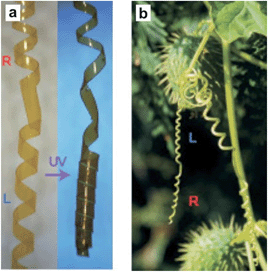 | ||
| Fig. 3 (a) Upon UV irradiation, mixed-helicity springs prepared from azobenzene-containing crosslinked LC polymers exhibit complex photomechanical response: the left-handed helix winds and the right-handed unwinds. (b) A coiled tendril of a wild cucumber plant. Reproduced with permission from ref. 83. Copyright 2014, Nature Publishing Group. | ||
Other potentially interesting developments that may open up new prospects in azobenzene photomechanics derive from the use of (i) complex liquid-crystal order and (ii) complex liquid-crystal elastomer microstructures. Complex-ordered and patterned LC polymer networks have been most notably studied by Broer and coworkers.84,85 They used LC cells containing cinnamate-based photoalignment layers that were irradiated through a photomask with a wedge-shaped opening while slowly rotating the cells. Using these cells for photopolymerization, they were able to prepare various complex-ordered free-standing films with continuous change of the LC alignment direction (Fig. 4a). By using patterned molecular alignment, interesting photothermal actuators exhibiting, e.g., checkerboard patterns upon stimulus (Fig. 4b) were fabricated. As for LC-elastomeric microstructures, Wiersma and coworkers have recently used high-resolution 3D direct laser writing to fabricate woodpile structures (Fig. 5) constituting azobenzene-containing LC elastomers.86 Importantly, the structures seem to maintain a reasonable degree of molecular alignment upon the two-photon laser writing process. No photoactuation of the structures was reported. But being able to extend photoactuation towards complex structures/micropatterns surely widens the perspectives of elastomer-based photoactuators/photonic structures.
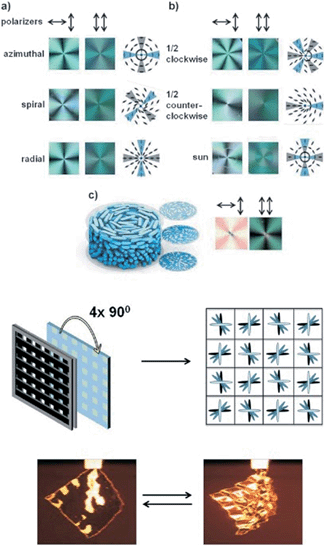 | ||
| Fig. 4 (a) Examples of crosslinked LC polymer films with circular alignment patterns as viewed between crossed or parallel polarizers. Bottom: illustration of circular twisted nematic alignment and images of the resulting film between perpendicular and parallel polarizers. Reproduced with permission from ref. 84. Copyright 2012, Wiley-VCH. (b) The deformation of crosslinked LC polymer films with checkerboard alignment pattern upon photothermal heating with IR light of a film with a checkerboard pattern. Reproduced with permission from ref. 85. Copyright 2013, Wiley-VCH. | ||
 | ||
| Fig. 5 Left: a 4-layer woodpile structure with 5 μm line distance and 1.3 μm distance between two consecutive layers. The structure is obtained by direct laser writing of azobenzene-containing LC elastomers. Right: polarized-optical micrographs of the LC elastomer woodpiles at different angles of the LC alignment direction with respect to the analyzer. Reproduced with permission from ref. 86. Copyright 2014, Wiley-VCH. | ||
Light-actuated crystals – fresh facets of research
While perhaps less easily prepared, and less amenable at present to materials applications in an engineering setting, photo-mechanics studies with single crystals and co-crystals of light-reversible small molecules can provide an enormous wealth of information for study. With crystals, one possesses an extremely clearly defined material system with well-defined atomic positions and orientations in the unit cell and with respect to macroscopic crystal faces. Photomechanical crystals can be used to measure and compare actuation response and X-ray diffraction in situ, for different polarizations of the light source.Photomechanical motion in bulk crystalline materials was first observed with a reversible shape and colour change of diarylethene crystals by the Irie group in 2007,24 where a clearly visible structural change was initiated by a pericyclic ring opening/closing reaction. The analysis and performance of these systems has since then been extended to estimate the amount of work that could be performed with light,87 determining the optimal thickness for actuators,88 and even a clever demonstration of how one can rotate a gearwheel with these crystals as a simple machine.89
In parallel and at about the same time, similar photo-mechanical effects were reported by Bardeen and co-workers on the photo-elongation or twisting of crystals of anthracene derivatives due to reversible [4 + 4] photodimerization,90 and since then they have similarly expanded to provide insight both on mechanism, extractable work, and some simple ‘device’ applications.91,92 Since these first two systems reported, others have also published such a salicylideneaniline system,93 where the shape change was governed by intra-molecular proton migration under irradiation, and a photo-mechanical effect seen in naphthalene diimide crystals bearing alkylamine groups.94 As with many applications of light-reversible phenomena, there is great potential for azobenzene materials due to their superior speed, reversibility, and tuneability, yet these same advantages also pose challenges for study. Importantly, one of the limitations of azobenzene photomechanical crystals, that of their limitation to high energy ultraviolet light for driving the underlying molecular transformations, can be easily circumvented by using azobenzenes with electron-donating and -accepting groups to redshift the driving wavelengths well into the low-energy visible region, preferable since it is far less damaging to organic molecules, and comprises a larger portion of the solar spectrum. Furthermore, the duration of the photomechanical cycle (from the beginning of irradiation until the crystal returns to its original shape) for previously reported crystals often was on the order of minutes or hours, which limits many practical applications. ‘Push–pull’ azobenzene chromophores however, exhibit comparatively shorter lifetimes of the cis-isomer, down to milliseconds, enabling the possibility of much faster switching and actuation.
The photo-mechanical bending of a thin azo crystal under ultraviolet (UV) irradiation was first reported in 2009 by Koshima et al.95 and, since then, a number of azo crystals have been grown and shown to be amenable to rapid, thermally reversible photo-mechanical bending,96 and investigation into the mechanism.97 Most recently, longer-lived photo-mechanical azo crystals have been provided by preparing halogenated azo compounds98–100 whose cis-isomers have sufficiently long thermal half-lives as to be isolated as single crystals for structural characterization. Therefore, the photo-mechanical transformation could be monitored in both states, and was discovered to proceed in a crystal-to-crystal manner, transforming a single crystal of cis into polycrystalline trans, thus providing the first opportunity for X-ray crystallography to follow each step of the photo-mechanical bending of azo crystals (Fig. 6).100
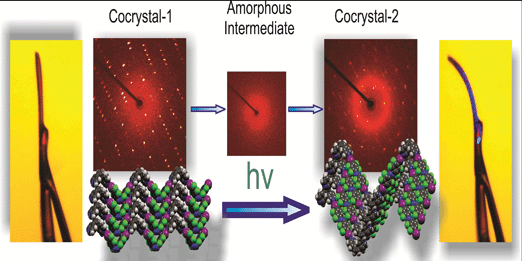 | ||
| Fig. 6 Photoinduced bending of halogen-bonded cocrystals followed by in situ X-ray diffraction reveals that the transition from the unbent cis single crystal to the bent polycrystalline trans state proceeds through an amorphous intermediate phase. Reproduced with permission from ref. 100. Copyright 2014, The Royal Society of Chemistry. | ||
Further studies and the design of photo-mechanical azo crystals are inherently limited by the number of available chromophores, challenges of synthesis and, ultimately, the morphology of crystals.99,100 In principle though, all of these limitations can be circumvented by rational crystal engineering that allows the modification of a number of solid-state properties through the formation of multi-component crystals (co-crystals), which has been successfully employed to tune the solid-state physicochemical properties of molecules.101 The formation of azo co-crystals has now been explored through several designs, including pi–pi stacking, molecular inclusion, hydrogen- and halogen-bonding.102
Conclusions and perspectives – a bright and rosy future
Precise and reversible control over molecular alignment and shape has emerged in recent years as a crucial key requirement for an array of applications such as reconfigurable photonic elements and optical-to-mechanical energy conversion. Soft materials such as liquid crystals and liquid-crystalline polymers have emerged as the most promising and exciting classes of materials to achieve these criteria effectively and efficiently, where molecular properties can be separately tailored and tuned to the requirements of a specific application. As a stimulus for reversible control over these properties, light should be considered by far as superior, for direct transfer of light energy into mechanical motion with no moving parts. Light is also an ideal triggering mechanism since it can be localized in time and space to allow for remote activation of a system, and is inherently a benign and gentle non-damaging stimulus. Thus for alignment control, actuation, and motion, photo-functional materials are of greatest recent interest. Azobenzene is the arguable leader amongst the small class of photo-reversible molecules, and soft azobenzene-containing materials are promising for next-generation photonic and photomechanical devices. Even single crystals and cocrystals containing azobenzene exhibit photomechanical response, demonstrating the power of this molecular switch even in constrained environments. In addition, new types of molecular switches and concepts for efficient photoalignment control are being developed. Twisting, aligning, and bending materials with light is an exciting scientific solution that can offer important and significant advantages to many applied fields, and warrants much further study and application.Notes and references
- E. K. Fleischmann and R. Zentel, Angew. Chem., Int. Ed., 2013, 52, 8810 CrossRef CAS PubMed.
- H. K. Bisoyi and S. Kumar, Chem. Soc. Rev., 2011, 40, 306 RSC.
- J. W. Goodby, Liq. Cryst., 2011, 38, 1363 CrossRef CAS.
- T. Kato, N. Mizoshita and K. Kishimoto, Angew. Chem., Int. Ed., 2006, 45, 38 CrossRef CAS PubMed.
- L. De Sio, N. Tabiryan, T. Bunning, B. R. Kimball and C. Umeton, Prog. Opt., 2013, 58, 1 Search PubMed.
- H. Yu and T. Ikeda, Adv. Mater., 2011, 23, 2149 CrossRef CAS PubMed.
- T. J. White, M. E. McConney and T. J. Bunning, J. Mater. Chem., 2010, 20, 9832 RSC.
- H. Coles and S. Morris, Nat. Photonics, 2010, 4, 676 CrossRef CAS.
- M. H. Dhammika Bandara and S. C. Burdette, Chem. Soc. Rev., 2012, 41, 1809 RSC.
- M. M. Russew and S. Hecht, Adv. Mater., 2010, 22, 3348 CrossRef CAS PubMed.
- S. Yagai and A. Kitamura, Chem. Soc. Rev., 2008, 37, 1520 RSC.
- A. A. Beharry and G. A. Woolley, Chem. Soc. Rev., 2011, 40, 4422 RSC.
- A. Goulet-Hanssens and C. J. Barrett, J. Polym. Sci., Part A: Polym. Chem., 2013, 51, 3058 CrossRef CAS.
- I. Janossy and A. D. Lloyd, Mol. Cryst. Liq. Cryst., 1991, 203, 77 CrossRef CAS.
- H. Zhang, S. Shiino, A. Shishido, A. Kanazawa, O. Tsutsumi, T. Shiono and T. Ikeda, Adv. Mater., 2000, 12, 1336 CrossRef CAS.
- T. Todorov, L. Nikolova and N. Tomova, Appl. Opt., 1984, 23, 4309 CrossRef CAS.
- M. Eich, J. H. Wendorff, B. Reck and H. Ringsdorf, Makromol. Chem., Rapid Commun., 1987, 8, 59 CrossRef CAS.
- K. Ichimura, K. Suzuki, T. Seki, A. Hosoki and K. Aoki, Langmuir, 1988, 4, 1214 CrossRef CAS.
- K. Ichimura, Chem. Rev., 2000, 100, 1847 CrossRef CAS PubMed.
- S. Tazuke, S. Kurihara and T. Ikeda, Chem. Lett., 1987, 16, 911 CrossRef.
- H. Finkelmann, E. Nishikawa, G. G. Pereira and M. Warner, Phys. Rev. Lett., 2001, 87, 015501 CrossRef CAS.
- T. Ikeda, M. Nakano, Y. Yu, O. Tsutsumi and A. Kanazawa, Adv. Mater., 2003, 15, 201 CrossRef CAS.
- Y. Yu, M. Nakano and T. Ikeda, Nature, 2003, 425, 145 CrossRef CAS PubMed.
- S. Kobatake, S. Takami, H. Muto, T. Ishikawa and M. Irie, Nature, 2007, 446, 778 CrossRef CAS PubMed.
- H. Yu, Prog. Polym. Sci., 2014, 39, 781 CrossRef CAS PubMed.
- T. Seki, Macromol. Rapid Commun., 2013, 35, 271 CrossRef PubMed.
- Z. Mahimwalla, K. G. Yager, J. Mamiya, A. Shishido, A. Priimagi and C. J. Barrett, Polym. Bull., 2012, 69, 967 CrossRef CAS.
- A. Natansohn and P. Rochon, Chem. Rev., 2002, 102, 4139 CrossRef CAS PubMed.
- J. A. Delaire and K. Nakatani, Chem. Rev., 2000, 100, 1817 CrossRef CAS PubMed.
- A. Natansohn and P. Rochon, Adv. Mater., 1999, 11, 1387 CrossRef CAS.
- T. Ikeda, J. Mater. Chem., 2003, 13, 2037 RSC.
- V. Shibaev, A. Bobrovsky and N. Boiko, Prog. Polym. Sci., 2003, 28, 729 CrossRef CAS.
- A. Shishido, Polym. J., 2010, 42, 525 CrossRef CAS.
- V. G. Chigrinov, V. M. Kozenkov and H. S. Kwok, Photoalignment of Liquid-Crystalline Materials, Wiley SID Series in Display Technology, 2008 Search PubMed.
- K. Miyachi, K. Kobayashi, Y. Yamada and S. Mizushima, SID Int. Symp. Dig. Tech. Pap., 2010, 41, 579 CrossRef.
- O. Yaroshchuk and Y. Reznikov, J. Mater. Chem., 2012, 22, 286 RSC.
- T. Seki, S. Nagano and M. Hara, Polymer, 2013, 54, 6053 CrossRef CAS PubMed.
- B. Y. Wei, W. Hu, Y. Ming, F. Xu, S. Rubin, J. G. Wang, C. Chigrinov and Y. Q. Lu, Adv. Mater., 2014, 26, 1590 CrossRef CAS PubMed.
- N. V. Tabiryan, S. R. Nersisyan, D. M. Steeves and B. R. Kimball, Opt. Photonics News, 2010, 21, 40 CAS.
- H. Yu, J. Mater. Chem. C, 2014, 2, 3047 RSC.
- K. Fukuhara, S. Nagano, M. Hara and T. Seki, Nat. Commun., 2014, 5, 3320 Search PubMed.
- A. Priimagi, K. Ogawa, M. Virkki, J. Mamiya, M. Kauranen and A. Shishido, Adv. Mater., 2012, 24, 6410 CrossRef CAS PubMed.
- M. Schadt, H. Seiberle and A. Schuster, Nature, 1996, 381, 212 CrossRef CAS.
- N. Kawatsuki, Chem. Lett., 2011, 40, 548 CrossRef CAS.
- N. Kawatsuki, H. Matsushita, M. Kondo, T. Sasaki and H. Ono, APL Mater., 2013, 1, 022103 CrossRef PubMed.
- R. Rosenhauer, C. Kempe, B. Sapich, M. Klein, E. Poetsch and J. Stumpe, Adv. Mater., 2012, 24, 6520 CrossRef CAS PubMed.
- T. Kosa, L. Sukhomlinova, L. Su, B. Taheri, T. J. White and T. J. Bunning, Nature, 2012, 485, 347 CrossRef CAS PubMed.
- N. V. Tabiryan, A. V. Sukhov and B. Y. Zel'dovich, Mol. Cryst. Liq. Cryst., 1986, 136, 1 CrossRef CAS.
- I. C. Khoo, Phys. Rep., 2009, 471, 221 CrossRef CAS PubMed.
- M. Peccianti and G. Assanto, Phys. Rep., 2012, 516, 147 CrossRef PubMed.
- I. C. Khoo, IEEE J. Quantum Electron., 1996, 32, 525 CrossRef CAS.
- L. Marrucci, D. Paparo, P. Maddalena, E. Massera, E. Prudnikova and E. Santamato, J. Chem. Phys., 1997, 107, 9783 CrossRef CAS PubMed.
- L. Lucchetti, M. Di Fabrizio, O. Francescangeli and F. Simoni, Opt. Commun., 2004, 233, 417 CrossRef CAS PubMed.
- I. A. Budagovsky, A. S. Zolot'ko, V. N. Ochkin, M. P. Smayev, A. Y. Bobrovsky, V. P. Shibaev and M. I. Barnik, J. Exp. Theor. Phys., 2008, 106, 172 CrossRef CAS.
- Y. Aihara, M. Kinoshita, J. Wang, J. Mamiya, A. Priimagi and A. Shishido, Adv. Opt. Mater., 2013, 1, 787 CrossRef.
- M. Yaegashi, M. Kinoshita, A. Shishido and T. Ikeda, Adv. Mater., 2007, 19, 801 CrossRef CAS.
- T. Mirfakhrai, J. D. W. Madden and R. H. Baughman, Mater. Today, 2007, 10, 30 CrossRef CAS.
- C. Ohm, M. Brehmer and R. Zentel, Adv. Mater., 2010, 22, 3366 CrossRef CAS PubMed.
- A. Lendlein, H. Y. Jiang, O. Junger and R. Langer, Nature, 2005, 434, 879 CrossRef CAS PubMed.
- S. V. Ahir and E. M. Terentjev, Nat. Mater., 2005, 4, 491 CrossRef CAS PubMed.
- X. Zhang, Z. Yu, C. Wang, D. Zarrouk, J. W. T. Seo, J. C. Cheng, A. D. Buchan, K. Takei, Y. Zhao, J. W. Ager, J. Zhang, M. Hettick, M. C. Hersam, A. P. Pisano, R. S. Fearing and A. Javey, Nat. Commun., 2014, 5, 2983 Search PubMed.
- T. Ikeda, J. Mamiya and Y. Yu, Angew. Chem., Int. Ed., 2007, 46, 506 CrossRef CAS PubMed.
- H. Kroener, T. J. White, N. V. Tabiryan, T. J. Bunning and R. A. Vaia, Mater. Today, 2008, 11, 34 CrossRef.
- C. L. van Oosten, C. W. M. Bastiaansen and D. J. Broer, Nat. Mater., 2009, 8, 677 CrossRef CAS PubMed.
- A. Priimagi and A. Shevchenko, J. Polym. Sci., Part B: Polym. Phys., 2014, 52, 163 CrossRef CAS.
- L. Matejka, M. Ilavsky, K. Dusek and O. Wichterle, Polymer, 1981, 22, 1511 CrossRef CAS.
- O. M. Tanchak and C. J. Barrett, Macromolecules, 2005, 38, 10566 CrossRef CAS.
- P. M. Hogan, A. R. Tajbakhsh and E. M. Terentjev, Phys. Rev. E: Stat., Nonlinear, Soft Matter Phys., 2002, 65, 041720 CrossRef CAS.
- M. H. Li, P. Keller, B. Li, X. Wang and M. Brunet, Adv. Mater., 2003, 15, 569 CrossRef CAS.
- N. Akamatsu, W. Tashiro, K. Saito, J. Mamiya, M. Kinoshita, T. Ikeda, J. Takeya, S. Fujikawa, A. Priimagi and A. Shishido, Sci. Rep., 2014, 4, 5377 Search PubMed.
- M. Yamada, M. Kondo, J. Mamiya, Y. Yu, M. Kinoshita, C. J. Barrett and T. Ikeda, Angew. Chem., Int. Ed., 2008, 47, 4986 CrossRef CAS PubMed.
- F. Cheng, R. Yin, Y. Zhang, C. C. Yen and Y. Yu, Soft Matter, 2010, 6, 3447 RSC.
- K. M. Lee, H. Kroener, R. A. Vaia, T. J. Bunning and T. J. White, Soft Matter, 2011, 7, 4318 RSC.
- S. Armon, E. Efrati, R. Kupferman and E. Sharon, Science, 2011, 333, 1726 CrossRef CAS PubMed.
- S. J. Gerbode, J. R. Puzey, A. G. McCormick and L. Mahadevan, Science, 2012, 337, 1087 CrossRef CAS PubMed.
- D. R. Warrick, B. W. Tobalske and D. R. Powers, Nature, 2005, 435, 1094 CrossRef CAS PubMed.
- T. L. Hendrick, B. Cheng and X. Deng, Science, 2009, 324, 252 CrossRef PubMed.
- K. M. Lee, M. L. Smith, H. Kroener, N. Tabiryan, R. A. Vaia, T. J. Bunning and T. J. White, Adv. Funct. Mater., 2011, 21, 2913 CrossRef CAS.
- K. D. Harris, R. Cuypers, P. Scheibe, C. L. van Oosten, C. W. M. Bastiaansen, J. Lub and D. J. Broer, J. Mater. Chem., 2005, 15, 5043 RSC.
- Y. Sawa, F. Ye, K. Urayama, T. Takigawa, V. Gimenez-Pinto, R. L. B. Selinger and J. V. selinger, Proc. Natl. Acad. Sci. U. S. A., 2011, 108, 6364 CrossRef CAS PubMed.
- K. M. Lee, T. J. Bunning and T. J. White, Adv. Mater., 2012, 24, 2839 CrossRef CAS PubMed.
- J. J. Wie, K. M. Lee, M. L. Smith, R. A. Vaia and T. J. White, Soft Matter, 2013, 9, 9303 RSC.
- S. Iamsaard, S. J. Aßhoff, B. Matt, T. Kudernac, J. L. M. Cornelissen, S. P. Fletcher and N. Katsonis, Nat. Chem., 2014, 6, 229 CrossRef CAS PubMed.
- L. T. de Haan, C. Sánchez-Somolinos, C. W. M. Bastiaansen, A. P. H. J. Schenning and D. J. Broer, Angew. Chem., Int. Ed., 2012, 51, 12469 CrossRef CAS PubMed.
- L. T. de Haan, V. Gimenez-Pinto, A. Konya, T. S. Nguyen, J. M. N. Verjans, C. Sánchez-Somolinos, J. V. Selinger, R. L. B. Selinger, D. J. Broer and A. P. H. J. Schenning, Adv. Funct. Mater., 2013, 24, 1251 CrossRef.
- H. Zeng, D. Martella, P. Wasylczyk, G. Cerretti, J. C. Gomez Lavocat, C. H. Ho, C. Parmeggiani and D. S. Wiersma, Adv. Mater., 2014, 26, 2319 CrossRef CAS PubMed.
- F. Terao, M. Morimoto and M. Irie, Angew. Chem., Int. Ed., 2012, 51, 901 CrossRef CAS PubMed.
- D. Kitagawa and S. Kobatake, Photochem. Photobiol. Sci., 2014, 13, 764 CAS.
- F. Terao, M. Morimoto and M. Irie, Angew. Chem., Int. Ed., 2012, 51, 901 CrossRef CAS PubMed.
- R. O. Al-Kaysi, A. M. Müller and C. J. Bardeen, J. Am. Chem. Soc., 2006, 128, 15938 CrossRef CAS PubMed.
- T. Kim, M. K. Al-Muhanna, S. D. Al-Suwaidan, R. O. Al-Kaysi and C. J. Bardeen, Angew. Chem., Int. Ed., 2013, 52, 6889 CrossRef CAS PubMed.
- T. Kim, L. Zhu, L. J. Mueller and C. J. Bardeen, J. Am. Chem. Soc., 2014, 136, 6617 CrossRef CAS PubMed.
- H. Koshima, R. Matsuo, M. Matsudomi, Y. Uemura and M. Shiro, Cryst. Growth Des., 2013, 13, 4330 CAS.
- Y. Matsunaga, K. Goto, K. Kubono, K. Sako and T. Shinmyozu, Chem.–Eur. J., 2014, 20, 7309 CrossRef CAS PubMed.
- H. Koshima, N. Ojima and H. Uchimoto, J. Am. Chem. Soc., 2009, 131, 6890 CrossRef CAS PubMed.
- O. S. Bushuyev, T. A. Singleton and C. J. Barrett, Adv. Mater., 2013, 25, 1796 CrossRef CAS PubMed.
- N. K. Nath, L. Pejov, S. M. Nichols, C. Hu, N. I. Saleh, B. Kahr and P. Naumov, J. Am. Chem. Soc., 2014, 136, 2757 CrossRef CAS PubMed.
- D. Bléger, J. Schwarz, A. M. Brouwer and S. Hecht, J. Am. Chem. Soc., 2012, 134, 20597 CrossRef PubMed.
- O. S. Bushuyev, A. Tomberg, T. Friščić and C. J. Barrett, J. Am. Chem. Soc., 2013, 135, 12556 CrossRef CAS PubMed.
- O. S. Bushuyev, T. C. Corkery, C. J. Barrett and T. Friščić, Chem. Sci., 2014, 5, 3158 RSC.
- D. Kitagawa and S. Kobatake, J. Phys. Chem. C, 2013, 117, 20887 CAS.
- M. Saccone, G. Terraneo, T. Pilati, G. Cavallo, A. Priimagi, P. Metrangolo and G. Resnati, Acta Crystallogr., Sect. B: Struct. Sci., Cryst. Eng. Mater., 2014, 70, 149 CAS.
| This journal is © The Royal Society of Chemistry 2014 |



